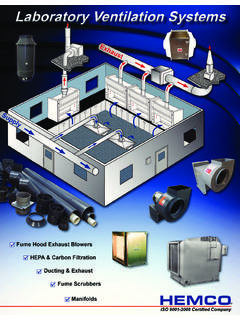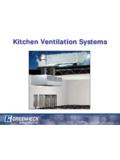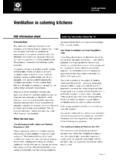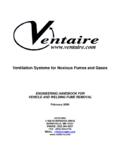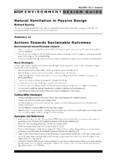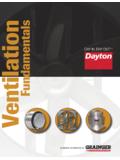Transcription of In-Depth Survey Report
1 In-Depth Survey Report An Evaluation of Local Exhaust ventilation Systems for Controlling Hazardous Exposures in Nail Salons David A. Marlow Timothy Looney Susan Reutman Division of Applied Research and Technology Engineering and Physical Hazards Branch EPHB Report No. 005-164 September 2012 DEPARTMENT OF HEALTH AND HUMAN SERVICES Centers for Disease Control and Prevention National Institute for Occupational Safety and Health EPHB Report No. 005-164 Page 2 Location of Laboratory Study: NIOSH Alice Hamilton Laboratory (Cincinnati, OH) NAICS Code: 812113 (Nail Salons) Study Conducted By: David A. Marlow, Timothy Looney, NIOSH/DART EPHB Report No. 005-164 Page 3 Disclaimer Mention of any company or product does not constitute endorsement by NIOSH. In addition, citations to websites external to NIOSH do not constitute NIOSH endorsement of the sponsoring organizations or their programs or products.
2 Furthermore, NIOSH is not responsible for the content of these websites. All Web addresses referenced in this document were accessible as of the publication date. EPHB Report No. 005-164 Page 4 Table of Contents Abstract .. 5 Introduction .. 6 Background for Control Technology Studies .. 6 Background for this Study .. 6 7 Control Technology .. 11 Description of the Evaluated Systems .. 11 Results .. 15 Discussion .. 18 Conclusions and Recommendations .. 19 References .. 20 Appendix A: Collection Efficiency Results for Exhaust ventilation system 1 .. 22 Appendix B: Collection Efficiency Results for Exhaust ventilation system 2 .. 24 Appendix C: Collection Efficiency Results for Exhaust ventilation system 3 .. 26 EPHB Report No. 005-164 Page 5 Abstract The National Institute for Occupational Safety and Health (NIOSH) conducted a laboratory research project to evaluate the effectiveness of local exhaust ventilation controls for preventing worker exposure to chemicals in nail salons.
3 Nail salon employees are potentially exposed to dozens of hazardous chemicals including acrylates, solvents, and biocides in the form of dusts or vapors. Exposure to these chemicals on the job have been examined by a small but growing number of studies that have found possible links between nail technicians work and adverse health outcomes including respiratory, neurological, and musculoskeletal disorders, as well as other health conditions including cancer. NIOSH asked prototype designers, commercial manufacturers, and vendors of downdraft ventilated nail tables (VNT) and portable nail salon source capture ventilation systems (SCV) that featured local exhaust recirculation to provide new, unused, downdraft units to be evaluated in this project. The NIOSH research project included an evaluation of airflow and capture characteristics of the units as well as noise levels around them.
4 Three different exhaust systems and four different collecting hoods were provided to NIOSH for this study. To quantitatively evaluate the capture efficiency of the ventilation system , a tracer gas method was used. Results of the tracer gas capture efficiency measurements for the various configurations showed the potential to reduce exposures by at least 50% - 60%. Exhaust system 2 (the silver shop vacuum) was the most efficient at removing potentially harmful chemicals during these tests. Results from the sound level readings also revealed that system 2 was the loudest of the three. Additional testing could be conducted to determine configurations that would improve collection efficiency. Practical testing in salons is necessary to determine if this arrangement would be accepted by nail technicians.
5 From the results of this research as well as stated industry needs, the following recommendations are made: Conduct additional studies with the nail table and exhaust hoods to determine optimum flow rates for increased capture efficiencies. Provide training to nail salon operators and employees about the importance of using engineering controls for processes that involve potentially hazardous chemicals. Investigate the requirements for salon ventilation to determine if current recommendations are adequate or if higher flows are more protective. Conduct CFD simulations of the various ventilation system and hood configurations to determine which provide the most protection for the worker. Conduct research on the filtration used in the ventilation units. Produce this information in easy to understand documents that will be made available to nail salon owners and workers.
6 EPHB Report No. 005-164 Page 6 Introduction Background for Control Technology Studies The National Institute for Occupational Safety and Health (NIOSH), Centers for Disease Control and Prevention (CDC) is the primary Federal agency engaged in occupational safety and health research. Located in the Department of Health and Human Services, it was established by the Occupational Safety and Health Act of 1970. This legislation mandated NIOSH to conduct a number of research and education programs separate from the standard setting and enforcement functions carried out by the Occupational Safety and Health Administration (OSHA) in the Department of Labor. An important area of NIOSH research deals with methods for controlling occupational exposure to potential chemical and physical hazards.
7 The Engineering and Physical Hazards Branch (EPHB) of the Division of Applied Research and Technology has been given the lead within NIOSH to study the engineering aspects of health hazard prevention and control. Since 1976, EPHB has conducted a number of assessments of health hazard control technology on the basis of industry, common industrial process, or specific control techniques. Examples of these completed studies include the foundry industry; various chemical manufacturing or processing operations; spray painting; and the recirculation of exhaust air. The objective of each of these studies has been to document and evaluate effective control techniques for potential health hazards in the industry or process of interest, and to create a more general awareness of the need for or availability of an effective system of hazard control measures.
8 Background for this Study NIOSH researchers are conducting initial laboratory studies to determine the effectiveness of several control technologies for reducing worker exposure to chemicals in nail salons. According to industry estimates, approximately 375,000 people are employed in nail salons and other personal care services in the United States [Drummey 2011]. The workforce in this industry is mostly female (96%) and also includes a large number of minority workers (63%). Nail salon employees are potentially exposed to dozens of hazardous chemicals including acrylates, solvents, and biocides in the form of dusts or vapors. Exposure to these chemicals on the job has been examined by a small but growing number of studies that have found possible links between nail technicians work and adverse health outcomes including respiratory, neurological, and musculoskeletal disorders, as well as other health conditions including cancer.
9 Nail technicians typically perform manicures and apply artificial fingernails over a workstation or nail table with the client s hands resting on the table top as the technician completes the work. Due to the proximity of the technicians breathing zone to the chemicals used in the manicure process, exposure to these chemicals represents a reason for concern. To protect nail salon workers from these chemical exposures, various types of engineering controls may be employed. These may include downdraft ventilated tables, portable source capture exhaust ventilation EPHB Report No. 005-164 Page 7 systems, and ventilation systems that remove contaminants before they cross the breathing zone. Down- or side-draft nail ventilation pulls contaminated air from near the area where products are placed or used to prevent it from reaching the face and being inhaled as the contaminated air crosses the breathing zone.
10 A downdraft table uses ventilation pulled through the table s top to remove particulate and vapor contaminants. A portable SCV system is a device that hooks to a source of ventilation to provide local ventilation , typically to the area where products are placed or used. These engineering control systems provide the means to remove potentially harmful exposures from the workplace. Because it is desirable to remove contaminated air before it crosses the breathing zone, ventilation systems that do not feature down- or side-draft ventilation were not included in this evaluation. There are a number of commercially available sources of engineering control solutions for nail salon applications. NIOSH undertook a unique research project to examine the effectiveness of different local exhaust ventilation systems in removing potential exposures from the work area.










